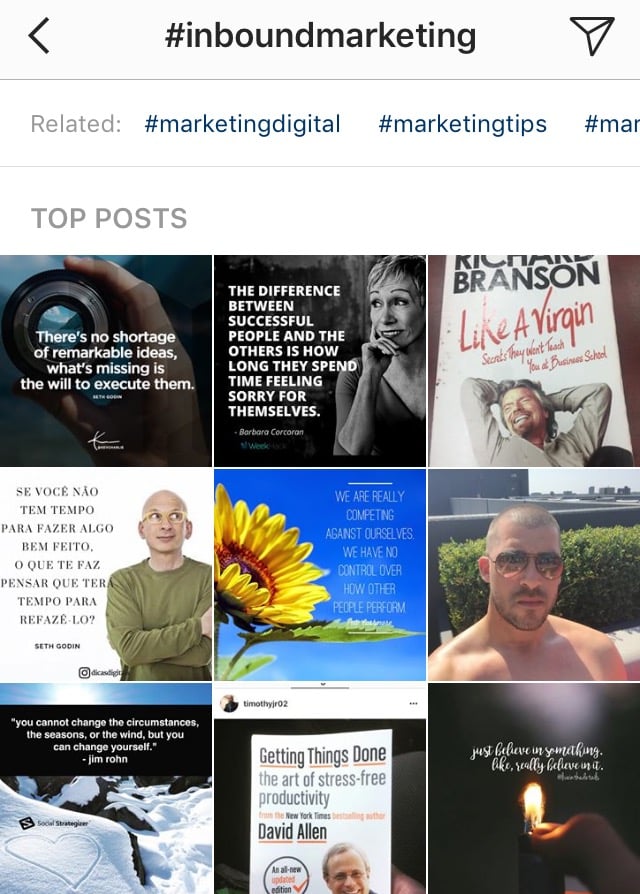
You might already know that Instagram is a growing channel that lets individuals and businesses alike expand their brand. For businesses especially, it's a way to humanize your brand, recruit future employees, showcase your product and company culture, delight customers, and generate new business.
But here's the deal: Unless you're famous, it's really hard to amass a huge following on Instagram without some hard work.
For the average person or business, growing your following takes time and attention on a daily basis. And although you may be tempted to buy your first several followers to get the ball rolling, purchased followers are either fake or low-quality profiles -- so they really serve no purpose except to artificially inflate your follower count. Don't count on any meaningful engagement or business interactions from these folks.
Luckily, there are a few things you can do right away to collect at least 1,000 quality followers for your personal or professional Instagram account. It's all about knowing where to invest your time and effort -- which is exactly what we'll show you in this post.
Download the complete guide to using Instagram for business and marketing here.
Let's go through how to gain those first 1,000 followers, from creating a follow-worthy Instagram profile to using contests to staying true to your brand. (Looking for inspiration? Read this blog post to browse through 17 of the best brands on Instagram.)
How to Get More Followers on Instagram
1) Create and optimize your profile.
First things first: Customize your Instagram profile to make it look good, tell your potential followers who you are, and give them a reason to follow you.
How? Start by making sure your username is recognizable and easily searchable -- like your business name. If your business name is already taken, try keeping your business name as the first part of your username so that people searching for your business are more likely to come across you. For example, the Australian activewear line Lorna Jane uses the username @lornajaneactive.
(Note: Make sure to add your full business name to the “Name” field in the "Options" section -- the gear button on iOS, or three dots on Android). This will appear under your profile picture and under your username in search.
Next, make sure your profile is public. To make your profile public, open Instagram, open "Options," and make sure "Private Account" is turned off.

Next, choose a profile picture that's on-brand with your other social networks, like your company logo.
Then, fill your bio with delightful, actionable, and informative information about your brand. Information like this lets people know what you're about and gives them a reason to follow you. Include who you are and what you do, and be sure to add a hint of personality. Here are a few examples for inspiration:
- @WeWork: "Make a life, not just a living."
- @Oreo: "See the world through our OREO Wonderfilled lens."
- @CalifiaFarms: "Crafting, concocting and cold-brewing up a delicious, plant-based future. Califia Farms Loves You Back"
- @Staples: "We make it easy to #MakeMoreHappen"
Next, add a link to your bio to make it easy for people to go straight from Instagram to your website if they want to. The space allotted for URLs is precious real estate because it's the only place within Instagram where you can place a clickable link, so use it wisely. We recommend using a shortened, customized Bitly link to make it more clickable.
Finally, enable notifications so you can see when people share or comment on your photos. This'll let you engage with them more quickly -- just like a lot of companies do on Twitter. To enable notifications, go to "Options" and then "Push Notification Settings." Select "From Everyone" for every category.
A word to the wise: We don't recommend you link your Instagram account to Twitter and Facebook so your Instagram posts are automatically published on those other accounts. Post types are different.
2) Designate a content creator.
Just like there should be one (maybe two) people managing your other social media accounts, there should only be one or two people managing your Instagram account. If possible, choose someone who has experience using a personal Instagram account, and therefore "gets" the platform -- and be sure they know all the handy features Instagram has to offer.
If you work for a large organization, you might find that a lot of people want to have a say in what's posted. That's when an organized request or guidelines document comes in hand. This document should inform people how to request a post on your Instagram account, when, the value of the post, and why.
3) Brush up on your photography and editing skills.
On Instagram, post quality matters. A lot. Your Twitter followers might forgive a few bad tweets, but a bad photo on Instagram is a big no-no. By no means do you have to take a photography course to be a good Instagram poster -- nor do you have to practice for weeks before you start. But you should get familiar with basic photography tips and photo editing apps.
Photography Skills
Since Instagram is a mobile app, chances are, most of the photos you post to Instagram will be taken on your mobile device. That's not just okay; it's expected. While some brands use professional photography for their Instagram photos, most use smartphones -- and that's the vibe that Instagram is meant for, anyway.
Start by reading this blog post on tips for taking great pictures on your smartphone. Here are some highlights:
- Focus on one subject at a time.
- Embrace negative space.
- Find interesting perspectives.
- Look for symmetry.
- Capture small details.
- Make your followers laugh.
(Click here for all 18 tips on taking great pictures with your smartphone.)
Photo Editing Skills
Instagram has some basic editing capabilities, but oftentimes, they aren't adequate to make a picture really, really great. Most of your photos should go through at least one or two other photo editing apps on your mobile phone before you open them in Instagram for the first time.
Read this blog post for a list of the best photo and video editing apps for mobile devices. These apps will let you do everything from sharpening specific parts of a photo to brightening certain hues to make your photo look fresher.
4) Start posting.
Once you've created and optimized your profile, have someone manning it, and know a thing or two about phone photography and photo editing, it's time to start posting. It's a good idea to have a solid number of great posts up -- maybe 15 or so -- before you start really engaging people and working down this list. That way, when people visit your profile, they'll see a full screen of photos instead of just a handful, so they know you'll be posting great content regularly.
To start posting on Instagram, first download this social media content calendar template and start planning out your Instagram posts. Over time, you'll want to build up a backlog of photos for times of need, like the weekends or when you go on vacation.
Keep your target persona in mind when you first start planning out your posting schedule, as that can drastically change your posting timing and frequency -- especially if you're targeting an audience in a different time zone. (Download this free template for creating buyer personas if you don't have a few already.)
While optimizing your schedule for your specific audience will take time and experimentation, we created this infographic using recent data on the best times to publish on every social media network to get you started. Our sources found that the very best times to post on Instagram were Mondays and Thursdays at any time except between 3:00–4:00 p.m. for the time zone of your target persona. (For a United States audience, your best bet is to combine Eastern and Central time zones, as they represent almost 80% of the U.S. population. For audiences located outside the U.S., use whichever time zones your target audience uses.)
However, because Instagram is primarily an app for use on mobile devices, users tend to use the network all the time, any time -- although many users engage with content more during off-work hours than during the workday. Some businesses have also seen success with posting at 2:00 a.m., 5:00 p.m., and Wednesdays at 7:00 p.m. Experiment with these to see if they work with your audience.
5) Curate some of your content.
Although it's best to have only one or two people manning your account, one or two people can't be everywhere at once taking photos. What about that fun sushi night the engineers had last night? Or the event your head of sales spoke at earlier this week? There's a whole breadth of content you'll want to post to Instagram, and more often than not, one person won't be able to keep track of it all.
One solution? Create a system where you can curate photos and content from members of your team. There are a few ways to do this. One is to create a specific email address for employees to send their photos, short videos, memes, hyperlapses, and so on. Just encourage people to put a subject line on these emails so you can more easily sort through the photos they're sending. While this doesn't seem like the smoothest way to curate photos, it's actually the easiest for the people sending you photos -- and the easier you can make it for them to send content, the more content you'll get.
If your team shares a Box or Dropbox account, you could also create a shared folder where people can automatically drop their photos and videos. This just makes a few more steps for the people sending you the content, and not everyone might have that app downloaded on their phones.
6) Write delightful, share-worthy captions.
Photos and videos might be the most important part of your Instagram posts, but captions should never be an afterthought. They're an essential part of your post -- icing on the cake, if you will. Consistently great captions can do wonders for humanizing your brand, winning over followers, and making your content more shareable -- thereby giving you more exposure.
My colleague Ryan Bonnici once told me, for example, that he loves Frank Bod's Instagram account for their captions: "Their witty captions will be your new obsession." On a photo of a gold necklace, @frank_bod's caption read: "I can't give you jewellery, but I can give you the smoothest décolletage to wear it on, babe. #letsbefrank."
The voice is filled with personality -- note the cheeky hashtag #letsbefrank, which often follows captions like this one. Fans of the Frank Bod use that hashtag to post photos of themselves covered in the product like the brand's own models, which is a great way for them to interact with and feel close to the brand.
Another way to increase the shareability of your caption and engage your followers is to ask questions or have some sort of call-to-action in the captions of your photos. For example, you might say, "double-tap if you find this funny" or "share your story in the comments." In the example below, we asked followers to share photos of their desk with the @HubSpot Instagram account for the chance to be featured.
7) Use relevant hashtags.
Let's go back to hashtags for a second. On Instagram, a hashtag ties the conversations of different users who wouldn't already be connected into a single stream. If you use relevant hashtags, your posts will get exposure to a wider audience than the people who already follow you or know about your brand. (Read this guide on how hashtags work on Instagram for more detailed tips.)
The key to using hashtags effectively is to use them smartly and sparingly. Try to limit the number of hashtags per caption to around three. Similarly, don't use "like for like" hashtags, like #like4like or #like4likes. This is a dirty tactic that'll leave you with a whole bunch of low-quality followers.
To find the hashtags your audience might be using, do a little research on relevant hashtags in your niche or industry. The easiest way to do this research is in the Instagram app itself, in the "explore" tab (i.e. the magnifying glass icon). When you search for one hashtag, it'll show you a list of related hashtags at the top of your screen. For example, when I search for #inboundmarketing on Instagram, it shows me relevant hashtags like #marketingdigital, #marketingtips, and so on.

To help relate to your followers on a personal level, you might consider hopping on hashtag trends like #tbt ("Throwback Thursday"), #MotivationMonday, #TransformationTuesday, or hashtags that are trending at any given time. Here's a post from @HubSpot's account using the #MotivationMonday hashtag:
Once you build up a bit of a following, you can try creating your own hashtags -- like your company name or a slogan that applies to a lot of your photos. This is a great way to build up your brand on the platform and build a more cohesive presence.
8) Interact with other users, including your followers.
Instagram is very much a community, and one great way to get involved in that community is to find people who post pictures that interest you, and follow their accounts and interact with their content. It's the most natural way to draw attention to your own Instagram account while getting your foot in the door in the community, and getting inspiration from others' content.
That does two things for you: For one, when they get the notification that you've followed them, they might check out your account and decide whether or not to follow you. (This is why it's important to have some great content on there before you start reaching out to others.) Secondly, it means you'll be seeing their recent posts in your feed, so you can Like and interact with them if you choose to.
As you build a following, celebrate your followers and show you appreciate them by responding to their comments, and even following them and engaging with their posts.
9) Cross-promote with users who have audiences similar to your own.
Once you build a solid relationship with some of the folks behind these accounts that have a similar audience to your own, you might ask to do some co-promotion on each others' accounts. The more natural and less spammy you can make the content of these cross-promotions -- especially the captions -- the better. It also helps to be picky about them, and don't do them very often.
Below is an example of what that looks like from food blogger @sprinklesforbreakfast and photographer @graymalin, who cross-promoted each others' accounts at about the same time:
10) Run Instagram contests.
Another great way to expand your reach while increasing engagement on your photos is to publish a post promoting a contest, and then ask people to follow your account and Like or comment on the photo in order to enter.
You might add a UGC (User-Generated Content) element to the contest, too, where people post a photo of their own and use a specific hashtag along with following your account. Here's an example of a post from Starbucks promoting a UGC contest on their Instagram account.
(Read this post for more tips on how to run a successful Instagram contest.)
11) Share Instagram Stories and live videos.
Instagram has always offered the opportunity to post beautiful, curated photos to represent your brand. However, with the introduction of ephemeral Instagram Stories, brands can also share on-the-fly, behind-the-scenes looks for 24 hours that may not be as polished as a published photo, but give your brand more personality on the platform. One look at Snapchat's explosion in popularity demonstrates that social media users are clearly responding positively to ephemeral photo and video sharing. Instagram Stories let brands engage with users in different ways to cultivate brand loyalty and appeal.
Instagram Stories also lets users share live videos, another content format that's proven to be hugely popular on other social networks. What's unique about live videos on Instagram? They disappear when users stop filming. This authentic, bi-directional experience lets brands share unscripted, raw moments with their audience to incorporate human elements into a social media platform that's highly edited and polished in its traditional use.
How Brands Can Use Instagram Stories
We can't include Instagram Stories in this article (they disappear after 24 hours), but here are a few brands we recommend following to see what they're sharing:
Rachel Brathen (@yoga_girl) is a yoga teacher and entrepreneur in Aruba who uses Instagram Stories to document the behind-the-scenes action of building a yoga studio. While her Instagram portfolio features beautiful, professional photos and videos of her in yoga poses, her Stories feature her dog sitting in on staff meetings, her team unwrapping amethyst crystals to decorate her studio, and artists painting the walls. She uses Stories to showcase the other side of her brand to her 2 million followers in an authentic and unpolished way, and to keep her followers apprised of what she does every day (besides yoga, of course).
Dana Shultz (@miniamlistbaker) publishes easy vegan and gluten-free recipes on her blog. Her Stories feature neat how-to videos of her making breakfast and testing out new recipes in her kitchen. The behind-the-scenes aspect of her Stories provide a lot of human context for her blog's brand, and everybody loves a good how-to video.
Casper (@casper) publishes quirky Instagram content to advertise their mattresses -- without overtly doing so. The main theme of their content? Staying in is better than going out (because you can stay in and lay on a comfy Casper mattress, naturally). They've even created a gallery for followers to use as backdrops for their Snapchat and Instagram stories to make it look like they're out at a party, when they're really laying in bed. One of their latest Instagram Stories featured someone watching "The Sopranos" in bed, with the caption: "Who needs plans when you have five more seasons?" This video supports Casper's campaign to stay in bed with a very real look at what millions of people do when they're hanging out at home.
Here are our tips for using Instagram Stories for your brand:
- Whether it's funny, sad, or unique, be authentic. Your photo gallery is where content can be perfect and polished. Instagram Stories are for the raw, unscripted, and unretouched. Use Stories to share the other side of your brand that followers might not be able to glean elsewhere. Do you have a dog-friendly office? Is your team trying out the Mannequin Challenge? Start filming to showcase the more human side of your brand.
- Go behind-the-scenes. These are by far our favorite type of content for ephemeral video sharing. Show your followers what goes into the planning of an event or the launching of a product, and make it fun. Your followers want to feel included and in-the-know, and you could use Stories to cultivate a brand loyalty program that only rewards people who check out your content.
- Go live. Live video is a growing trend across a variety of social media platforms, so if something interesting is happening, start rolling. Whether it's a team birthday party, a staff meeting, or a cute animal, your devoted followers want to see what you're up to every day. Take Stories to the next level by sharing them as they happen (and promoting it on Twitter or Facebook to get followers to tune in).
Experiment with sharing Stories and live, ephemeral content to attract new followers and to increase engagement with the ones you already have. Learn how to share Stories and go live in these blog posts.
12) Make your profile easy to find and follow.
Place a follow button on your homepage, your "About Us" page, and various other places on your website. You can generate a "badge" button that links to your account on Instagram's website here. Just make sure you're logged into the right account when you create it. Here's what one of the badge options looks like:

If your brand has brick-and-mortar locations, put out a good ol' print call-to-action letting people know you have an Instagram account and encouraging them to follow you.
Also, be sure to promote your Instagram account on your other social media accounts. Chances are, the folks who already follow you on Facebook and Twitter will also follow you on Instagram without much prodding. Let those followers know you're on Instagram and encourage them to follow you there by including a link to your Instagram account in the bios and posts of those other social media accounts.
So give it a shot: Make a profile and start posting, testing, tweaking, and promoting your account. Garnering a following on Instagram won't happen overnight, but the stronger of a foundation you create on your account in in your niche Instagram community, the higher quality your followers will be.
What other tips do you have for gaining followers on Instagram? Share with us in the comments.
Editor's Note: This post was originally published in February 2016 and has been updated for accuracy and comprehensiveness.
from HubSpot Marketing Blog https://blog.hubspot.com/marketing/gain-instagram-followers


No comments:
Post a Comment